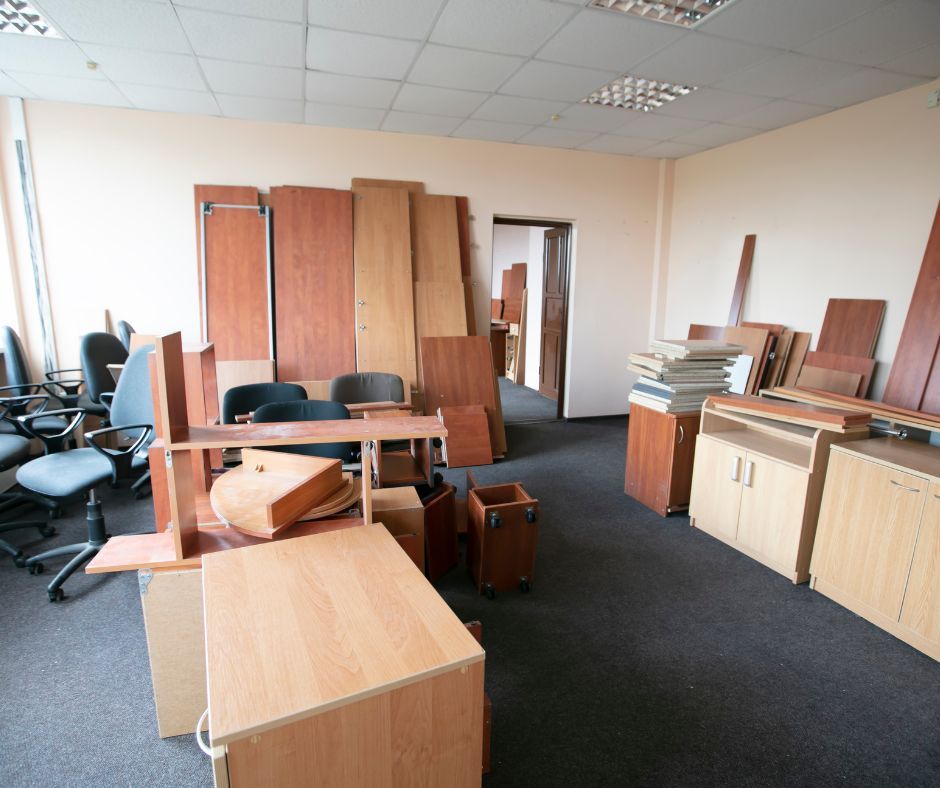
Moving can be daunting, especially when you think about bulky furniture pieces. The thought of how to disassemble furniture for moving and pack them safely for the move can be overwhelming. But you can make the process smoother with the right tools and a step-by-step guide. Whether you’re a DIY enthusiast or considering hiring a pro , this guide will walk you through the entire process.
Why Disassembling Furniture for Moving is Crucial?
Disassembling furniture for moving has several benefits:
- Minimizing Large Shapes : It makes the Tetris packing game in themoving truck much easier.
- Separating Weight : Reduces the strain on your body when moving.
- Preventing Property Damage : Avoids scratches on doorways and hallways.
- Avoiding Personal Injuries : Makes handling furniture safer.
Pre-Move Planning and Preparation
Before you dive into the disassembly process, some prep work is essential:
- Measure Furniture : Use a measuring tape to ensure your furniture will fit through doorways, hallways, and inside moving vehicles.
- Gather Tools : Essential tools include a screwdriver , hammer, pliers, wrench, and resealable bags for small parts.
- Labels and Tape : Label stickers help in organizing. Use tape to secure bubble wrap and other packing materials.
- Furniture Manuals : It is always handy to have furniture manuals for reference. They provide specific disassembly instructions.
- Packing Supplies : Stock up on bubble wrap, moving boxes, and furniture blankets.
Step-by-Step Guide to Disassembling Common Furniture Types
Couches and Sofas
- Empty the Furniture : Remove cushions, pillows, and any loose items.
- Detach Removable Parts : Unscrew furniture legs and armrests.
- Wrap : Use furniture blankets to wrap detached parts.
Beds
- Remove Bedding : Take off sheets, comforters, and mattresses.
- Disassemble the Frame : Unscrew the bed frame, headboard, and sideboards.
- Packing : Use bubble wrap for fragile parts like mirrors or glass pieces.
Desks and Tables
- Empty Drawers : Remove all items from drawers.
- Detach Legs : Use a screwdriver to unscrew the legs.
- Packing : Wrap more significant parts with furniture blankets.
Pro Tips for Efficient Disassembly
Efficient disassembly is crucial for various tasks, such as repairing, recycling, or studying the construction of complex objects. Here are some pro tips to help you disassemble items efficiently and safely:
- Gather Tools and Equipment: Before you start, gather all the necessary tools and equipment, such as screwdrivers, pliers, wrenches, Allen keys, gloves, safety glasses, and containers for organizing screws and small parts.
- Document the Process: Take photos or videos as you disassemble furniture for moving. This will serve as a reference when you’re reassembling it later. Make sure the photos are clear and well-lit.
- Read Manuals or Guides: Consult the manufacturer’s manual or online guides for disassembly instructions. This can save you time and prevent unnecessary damage.
- Organize Small Parts: Use small containers, bags, or magnetic trays to organize and store screws, bolts, and other small parts. Label them and keep them to make reassembly easier.
- Work in a Clear Area: Choose a well-lit, clean, and clutter-free workspace. This will help you keep track of parts and prevent accidental damage or loss.
- Safety First: Wear appropriate safety gear, such as gloves and safety glasses, especially when dealing with sharp edges, chemicals, or potential flying debris.
- Start from the Outside: Begin disassembly from the outer casing or shell. Remove any visible screws, clips, or fasteners that hold the case together.
- Follow a Systematic Approach: Work methodically, taking note of the order in which you’re removing parts. This will make reassembly easier and prevent confusion.
- Use the Right Tools: Use the correct tools for each job. Using the wrong tool can damage parts or make disassembly more complicated than necessary.
- Be Mindful of Connections: Pay attention to connectors, wires, or cables as you disassemble. Take photos of their connections before disconnecting to ensure proper reassembly.
- Bag and Label Components: If you’re disassembling a more complex item, like electronics, place components and parts in separate bags and label them with descriptions or diagrams for reference.
- Work Slowly and Carefully: Rushing through disassembly can lead to mistakes, lost parts, or broken components. Take your time and work carefully.
- Note Hidden Fasteners: Some items might have hidden screws or fasteners beneath stickers, labels, or rubber feet. Check for these before forcing any components apart.
- Avoid Force: If a part isn’t coming apart quickly, double-check for any missed screws or fasteners. Avoid using excessive force, as this could lead to damage.
- Document Steps: Alongside your photos, jot down notes about the disassembly process. This can be especially helpful when working on a complex item requiring reassembling.
- Keep a Clean Workspace: As you go, periodically clear away debris, screws, and parts you no longer need. This keeps your workspace organized and prevents confusion.
- Dispose of Hazardous Materials Properly: If you’re dealing with items that contain hazardous materials, such as batteries or chemicals, make sure to dispose of them according to local regulations.
- Reassembly Verification: Before you finish, double-check your photos and notes to ensure you’ve reassembled everything correctly. Test the item to make sure it functions as intended.
By following these pro tips, you can disassemble items efficiently and safely, allowing you to repair, recycle, or study them effectively.
- Ziploc Bags : Ideal for keeping screws, bolts, and nails. Label each bag for easy reassembly.
- Photograph the Process : Before you start, take pictures. It will help during reassembly.
- Avoid Force : Refer to the furniture manual if a part doesn’t come off quickly. Forcing can cause damage.
DIY vs. Hiring Professionals Disassemble Moving Company
The decision between DIY (Do It Yourself) and hiring professionals, such as a moving company, for disassembling and moving depends on your circumstances, resources, and preferences. Let’s break down the pros and cons of each option:
DIY Disassembly and Moving:
Pros:
- Cost Savings: Doing everything yourself can save money on hiring professionals.
- Control: You have complete control over the process, timeline, and organization.
- Flexibility: You can make last-minute changes and adjustments without coordinating with a moving company.
- Personal Attachment: If you’re attached to your belongings and want to ensure they are handled exactly as you’d like, doing it yourself might be more satisfying.
Cons:
- Labor and Time: Disassembling furniture and packing can be time-consuming and physically demanding.
- Skills and Tools: Some furniture might require specific tools and skills to disassemble appropriately, and you might need to invest in or borrow those tools.
- Risks of Damage: Inexperience could lead to improper disassembly and damage during the move.
- Stress: The entire process can be stressful and overwhelming, especially when moving a large household.
Hiring Professionals (Moving Company):
Pros:
- Expertise: Professional movers are experienced in disassembling, packing, and transporting items safely and efficiently.
- Time Savings: Movers can complete the process faster due to their experience and teamwork.
- Reduced Stress: You can offload the physical and logistical burdens onto the professionals, reducing your stress.
- Insurance: Reputable moving companies often provide insurance for your belongings in case of damage during the move.
- Equipment: Movers have the right equipment to handle different furniture and belongings.
Cons:
- Cost: Hiring professionals will likely cost more than doing it yourself.
- Less Control: You might have less control over the timing and process, as you’ll need to coordinate with the moving company.
- Trust and Research: You must research and choose a reliable and reputable moving company to ensure a smooth process.
- Less Personal Involvement: If you’re sentimental about your belongings, having others handle them might feel less personal.
Factors to Consider:
- Budget: Assess your budget to determine if hiring professionals is feasible.
- Time: Consider your timeline – professionals might be more efficient if you’re in a rush.
- Complexity: The complexity of disassembly and moving plays a role. Professionals should handle complicated furniture.
- Distance: The distance of your move can affect your decision. Longer distances benefit from professional handling to minimize potential damage.
- Health and Physical Ability: Your physical ability and fitness should be considered. DIY moves can be physically demanding.
FAQs: Common Questions About Furniture Disassembly
- Is it worth disassembling all the furniture? Only sometimes. Some items, like dining chairs, might be easier to move without disassembly.
- How long does it take to disassemble furniture? It varies. A bed might take 30 minutes, while a wardrobe could take up to an hour.
- What if I lose screws or bolts? Always pack them in sealable plastic bags and label them.
Disassembling furniture might seem tedious, but with the right approach, it can be straightforward. Proper preparation is critical for a DIY move or hiring interstate movers. Please remember, the goal is to ensure your furniture reaches its new home in perfect condition.
Have you recently moved? Share your furniture disassembly experiences and tips in the comments below. If you found this guide helpful, remember to share it with friends and family planning a move!
By incorporating these tips and techniques, you’ll be well-equipped to handle your next move, ensuring your furniture remains intact and ready for its new home. Safe moving!
The post How to Disassemble Furniture for Moving: A Comprehensive Guide appeared first on Treasure Moving.

